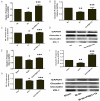Adenosine A2B receptor modulates intestinal barrier function under hypoxic and ischemia/reperfusion conditions
- PMID: 24966910
- PMCID: PMC4069946
Adenosine A2B receptor modulates intestinal barrier function under hypoxic and ischemia/reperfusion conditions
Abstract
Background: Intestinal barrier function failure from ischemia/reperfusion (I/R) and acute hypoxia has been implicated as a critical determinant in the predisposition to intestinal inflammation and a number of inflammatory disorders. Here, we identified the role of Adenosine A2B receptor (A2BAR) in the regulation of intestinal barrier function under I/R and acute hypoxic conditions.
Methods: C57BL/6J mice were used, and were randomized into three groups: Sham, I/R, IR+PSB1115 (a specific A2BAR antagonist) groups. After surgery, the small bowel was harvested for immunohistochemical staining, RNA and protein content, and intestinal permeability analyses. Using an epithelial cell culture model, we investigated the influence of hypoxia on the epithelial function, and the role of A2BAR in the expressions of tight junction and epithelial permeability. The expressions of Claudin-1, occludin and ZO-1 were detected by RT-PCR and Western-Blot. Epithelial barrier function was assessed with transepithelial resistance (TER).
Results and conclusions: The A2BAR antagonist, PSB1115, significantly increased tight junction protein expression after intestinal I/R or acute hypoxia conditions. PSB1115 also attenuated the disrupted distribution of TJ proteins. Furthermore, inhibition of A2BAR attenuated the decrease in TER induced by I/R or acute hypoxic conditions, and maintained intestinal barrier function. Antagonism of A2BAR activity improves intestinal epithelial structure and barrier function in a mouse model of intestinal I/R and a cell model of acute hypoxia. These findings support a potentially destructive role for A2BAR under intestinal I/R and acute hypoxic conditions.
Keywords: Ischemia/reperfusion; TER; ZO-1; adenosine A2B receptor; claudin-1; hypoxia; occludin; tight junction.
Figures





Similar articles
-
Aryl hydrocarbon receptor activation maintained the intestinal epithelial barrier function through Notch1 dependent signaling pathway.Int J Mol Med. 2018 Mar;41(3):1560-1572. doi: 10.3892/ijmm.2017.3341. Epub 2017 Dec 22. Int J Mol Med. 2018. PMID: 29286081 Free PMC article.
-
Changes in the expression levels of tight junction components during reconstruction of tight junction from mucosal lesion by intestinal ischemia/reperfusion.Eur J Drug Metab Pharmacokinet. 2014 Sep;39(3):211-20. doi: 10.1007/s13318-013-0151-z. Epub 2013 Sep 8. Eur J Drug Metab Pharmacokinet. 2014. PMID: 24014129
-
Cutting Edge: A2B Adenosine receptor signaling provides potent protection during intestinal ischemia/reperfusion injury.J Immunol. 2009 Apr 1;182(7):3965-8. doi: 10.4049/jimmunol.0802193. J Immunol. 2009. PMID: 19299692
-
The adenosine A2B G protein-coupled receptor: Recent advances and therapeutic implications.Pharmacol Ther. 2019 Jun;198:20-33. doi: 10.1016/j.pharmthera.2019.01.003. Epub 2019 Jan 22. Pharmacol Ther. 2019. PMID: 30677476 Review.
-
The resurgence of A2B adenosine receptor signaling.Biochim Biophys Acta. 2011 May;1808(5):1329-39. doi: 10.1016/j.bbamem.2010.05.016. Epub 2010 May 28. Biochim Biophys Acta. 2011. PMID: 20546702 Free PMC article. Review.
Cited by
-
Interleukin-28A maintains the intestinal epithelial barrier function through regulation of claudin-1.Ann Transl Med. 2021 Mar;9(5):365. doi: 10.21037/atm-20-5494. Ann Transl Med. 2021. PMID: 33842586 Free PMC article.
-
Relationship between G proteins coupled receptors and tight junctions.Tissue Barriers. 2018 Jan 2;6(1):e1414015. doi: 10.1080/21688370.2017.1414015. Epub 2018 Feb 8. Tissue Barriers. 2018. PMID: 29420165 Free PMC article. Review.
-
Cupping alleviates lung injury through the adenosine/A2BAR pathway.Heliyon. 2022 Dec 5;8(12):e12141. doi: 10.1016/j.heliyon.2022.e12141. eCollection 2022 Dec. Heliyon. 2022. PMID: 36544817 Free PMC article.
-
Dynamic Changes in Colonic Structure and Protein Expression Suggest Regulatory Mechanisms of Colonic Barrier Function in Torpor-Arousal Cycles of the Daurian Ground Squirrel.Int J Mol Sci. 2022 Aug 12;23(16):9026. doi: 10.3390/ijms23169026. Int J Mol Sci. 2022. PMID: 36012293 Free PMC article.
-
Inhibition of A2B Adenosine Receptor Attenuates Intestinal Injury in a Rat Model of Necrotizing Enterocolitis.Mediators Inflamm. 2020 Jul 3;2020:1562973. doi: 10.1155/2020/1562973. eCollection 2020. Mediators Inflamm. 2020. PMID: 32714089 Free PMC article.
References
-
- Daniel C, Sartory NA, Zahn N, Radeke HH, Stein JM. Immune modulatory treatment of trinitrobenzene sulfonic acid colitis with calcitriol is associated with a change of a T helper (Th) 1/Th17 to a Th2 and regulatory T cell profile. J Pharmacol Exp Ther. 2008;324:23–33. - PubMed
-
- Berland T, Oldenburg WA. Acute mesenteric ischemia. Curr Gastroenterol Rep. 2008;10:341–346. - PubMed
-
- Ogra PL, Welliver RC Sr. Effects of early environment on mucosal immunologic homeostasis, subsequent immune responses and disease outcome. Nestle Nutr Workshop Ser Pediatr Program. 2008;61:145–181. - PubMed
Publication types
MeSH terms
Substances
LinkOut - more resources
Full Text Sources
